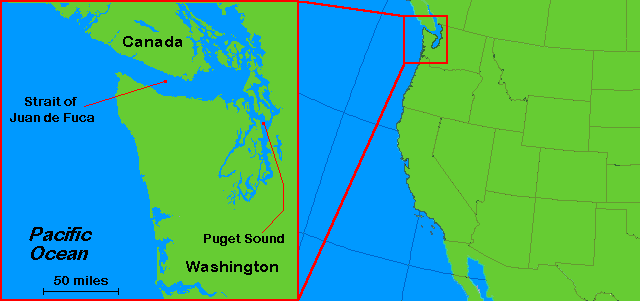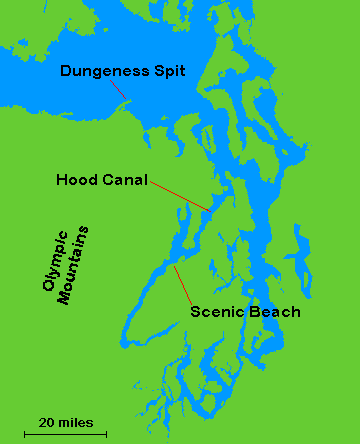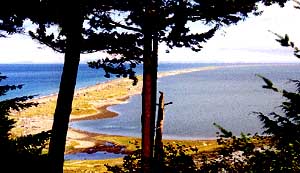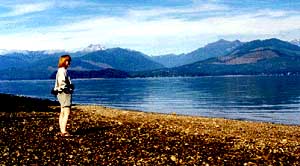
.

Washington state is blessed by many natural resources - dense pine forests, abundant rainfall, enormous volcanoes, and mountain streams where salmon lay their eggs. And one of its most remarkable natural resources is the Puget Sound, a network of deep-water bays and inlets where the Pacific Ocean reaches inland into what were once mountain valleys.
The Washington coast is part of the "Ring of Fire." The Ring of Fire is a name for the northern coast all around the Pacific Ocean, where volcanoes and earthquakes are common. These volcanoes and earthquakes are caused by tectonic plates (say, "tek-TAWN-ik plates"), which is a name for the big pieces of the earth's surface that slide around and bump into each other over eons of time. Washington is at the border of the Pacific plate and the North American plate. Where these two tectonic plates bump into each other, the earth's surface is wrinkled to form large mountain ranges. And when the plates shift even a tiny amount, it is an earthquake. Molten rock called magma bubbles up from deep inside the earth along the border between the plates, forming the volcanoes that give the Ring of Fire its name.
Long ago, the surface of the ocean was lower than it is today. (All that water was trapped in the vast glaciers of the Ice Age; when the glaciers melted, the ocean rose to its present depth.) In those days, the inlets of the Washington coast were mountain valleys filled with glaciers. But when the Ice Age glaciers melted, the Pacific Ocean crept into the valleys and flooded them to make the inlets of Puget Sound and the Strait of Juan de Fuca.
The Strait of Juan de Fuca is the name of the inlet where the Pacific Ocean enters the Washington coastline. A strait is a narrow inlet. The Strait of Juan de Fuca is over 80 miles long, but is only about 15 miles across. This strait is named for Juan de Fuca, a Greek sailor who explored the Pacific Ocean for Spain in the 16th century, and may have visited the strait in 1592.
Puget Sound is a branch off the south end of the Strait of Juan de Fuca. A sound is a long, broad inlet from the ocean that runs parallel to the coast. Sound is also a verb meaning "to measure the depth of water." Puget Sound runs north and south, parallel to the west coast of Washington. Puget Sound was explored by British explorer George Vancouver in 1792. He named the sound after Peter Puget, a lieutenant in his expedition.
The Strait of Juan de Fuca and Puget Sound contain many important ports. Their deep waters are sheltered by the Olympic mountains, and their calm waters give shelter and easy passage to ships. The cities of Olympia, Seattle, Tacoma, Vancouver, and Victoria benefit from these harbors.

| . | |
 | |
and the World's Longest Spit | |
| . | |
 | |
on the Hood Canal |